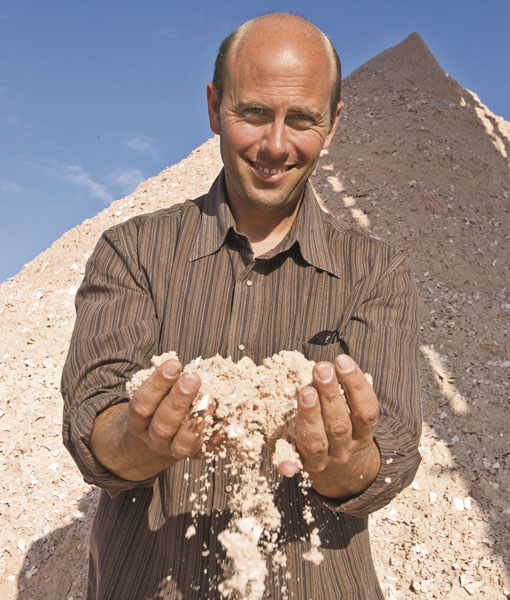Fixing Competition Footing for North American Dressage
14 years ago StraightArrow Comments Off on Fixing Competition Footing for North American Dressage

By KENNETH J. BRADDICK
When Bart Poels flew into Florida from his home in Belgium in 2007 to look at an opportunity to build a competition arena, he could not have guessed the revolution he would help spark in horse show footing in the United States.
In less than four years, the impact of the sand and fiber footing that Bart and his American partner Brett Raflowitz of Palm City, Florida, installed in place of a field of grass that became dirt after six weeks of non-stop jumping at the Palm Beach Equestrian Club, renamed the Palm Beach International Equestrian Center, became both good and bad for horse shows in North America.
The good is that it has provided competitors with the power to demand footing that will allow their horses, whether a priceless companion to their riders or a multimillion dollar Olympic mount, to show off to the best of their ability and emphatically do them no harm.
And there have been significant upgrades to all-weather surfaces, particularly on the U.S. East Coast, with more to come because of the requirement by the U.S. Equestrian Federation that administers CDI-Ws on behalf of the International Equestrian Federation that footing for World Cup events should be of similar high quality.
The bad is that organizers of shows trying to get by with anything less–in some cases arenas where horses run the risk of suffering harm–can no longer ignore complaints. High cost and a prohibition against major changes in footing at multipurpose venues have been among the obstacles to change.
World Cup competitions at Devon, Pennsylvania, and Loxahatchee, Florida, scheduled for 2012 were given only provisional approval, a first in the U.S., with a requirement to upgrade footing to meet higher standards. Devon has since been approved as a World Cup qualifier, though Loxahatchee has not yet made required changes.
Until this year, complaints about footing rarely became public. The U.S. Equestrian Federation has for years sought riders’ opinions about their sanctioned competitions, both national and CDIs, including comments on footing. But there often were not many choices for riders, especially as a lot of venues were taxpayer-owned multipurpose facilities that one week could host a CDI and the next a reining competition or Western pleasure class. Many riders admit privately that until recently they had little leverage and were guarded in their criticism as they wanted to support organizers who were staging competitions, frequently at a financial loss.
This year saw a dramatic change:
Complaints were voiced about the quality of footing at CDIs at:
–The Jim Brandon Equestrian Center in West Palm Beach, Florida, that led to the ground jury to take the unusual step of allowing riders to withdraw from the CDI Prix St. Georges, a qualifier for the selection trial for the U.S. team for the Pan American Games. The venue was put on notice to make improvements in time for a CDI5*, and the changes were made;
–The New Jersey Horse Park in Allentown when a Canadian Olympian accepting an award noted that other competitors were not the only challenge–so, too, was the footing;
–A U.S. rider forced to stop her horse that appeared to go three-legged lame in the midst of a World Cup qualifying event at Milton, Ontario, when a stone from the competition surface lodged in the foot. The horse the rider was aiming for the 2012 World Cup Final was returning to top level competition after months recovering from an injury;
–Seven of eight riders refused to start in a CDI3* Grand Prix at Pebble Beach, California, after organizers refused to switch to an adjoining arena when sand in the original ring was deemed much too deep, and
–Complaints over footing and other issues at a World Cup qualifying event in Loxahatchee, Florida, this year led to the Palm Beach Dressage Derby, for decades the premier competition on Florida’s winter circuit, receiving only provisional approval as a CDI-W for 2012. Improvements have to be made before full status is restored.
Debbie McDonald, one of America’s most successful riders winning Olympic and World Equestrian Games medals and a World Cup title with the mare Brentina, was directly involved in trying to negotiate moving the CDI Grand Prix competition to a different arena at Pebble Beach earlier this year. She has been a longtime proponent of improved footing and an Otto Sport all-weather arena was installed at River Grove Farm in Hailey, Idaho, where she was based with Brentina.
Debbie said she was gratified that all but one of the Grand Prix riders, many who had made a nine-hour drive from Southern California and 16 hours from Idaho, stuck together in refusing to ride in the arena where the footing was so deep that, she said, it could have been career-ending for a horse. She was disappointed at the refusal by management to move to an adjoining arena that riders agreed was acceptable–apparently because sponsor tents and judges boxes were placed around the original arena.
“It is not worth it,” she said.
“It is the first time the riders have said, ‘This is not OK’.”
California may never have the same quality of footing as Florida and that poses a problem for high performance riders in California, most of whom cannot to leave their businesses and homes and move 2,400 miles (3,860km) arose country for the winter circuit.
Most California show managers, she said, were fully committed to providing the best possible footing with what was available at the venues, most of which were multipurpose facilities.
Eva Salomon, the USEF Managing Director of Dressage, said the Dressage Committee understood the problems for organizers who stage dressage competitions at multipurpose facilities and the high cost of meeting higher standards.
But improved footing is a goal that will be achieved over time, she said, as it should be for U.S. riders.
The type of footing now available in some of the top dressage show grounds on the East Coast is almost universal for CDIs throughout Western Europe and of the quality installed by Bart Poels and Oliver Hoberg of Germany for the 2008 Olympic equestrian events in Hong Kong.
The financial outlay is significant, though.
Dressage at Devon on Main Line Philadelphia, one of the oldest and most prestigious competitions in the U.S. before the explosive growth of the Florida winter circuit, installed footing provided by Bart Poels’ Equestrian Services International (ESI) in its main arena in 2010 and added a second competition arena for this year’s show at the end of September.

The Kentucky Horse Park installed the German Otto Sport footing system in the main arena for the World Equestrian Games in 2010 that was highly praised by the hundreds of riders from all three Olympic disciplines–dressage, eventing and jumping–that competed on it.
The biggest commitment, though, is at the Palm Beach International Equestrian Center in Wellington.
Six new arenas are being installed by ESI specially for the inaugural 2012 Global Dressage Festival of five CDI competitions–two World Cup qualifiers, a 5* and the first non-championship Nations Cup in the Western Hemisphere.
The six arenas–including a ring in a planned covered arena that is big enough for three full size dressage rings–are being added to the 12 jumper/hunter show rings of the same quality already in use at PBIEC, making the facility probably the world’s largest complex of arenas with world class footing.
The drive to improve footing has attracted a growing number of European companies hoping to win a share of what they hope will be growing business in North America.
Among them is Martin Collins of Great Britain, which for years has provided what it bills as maintenance-free waxed footing, and England’s Andrews & Bowen that is providing the footing for next year’s London Olympics.

